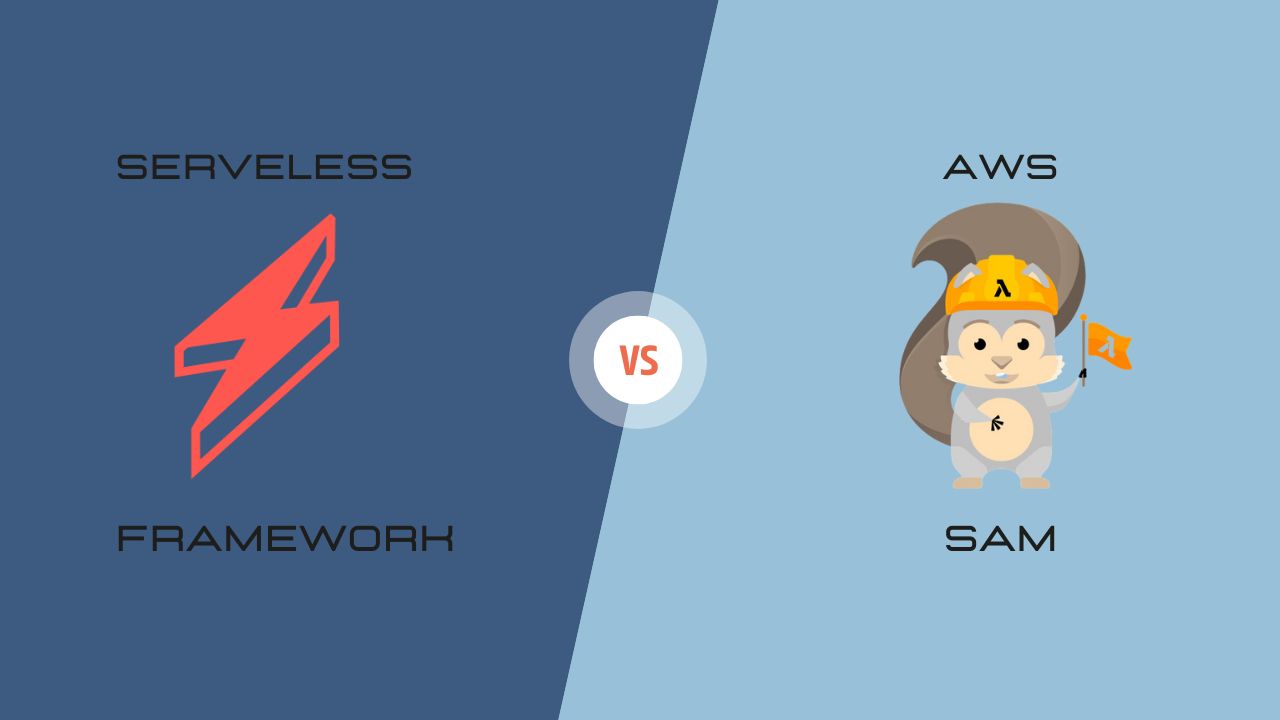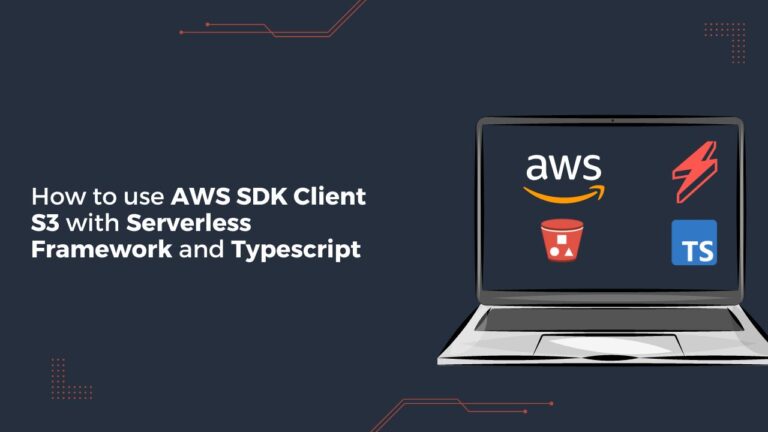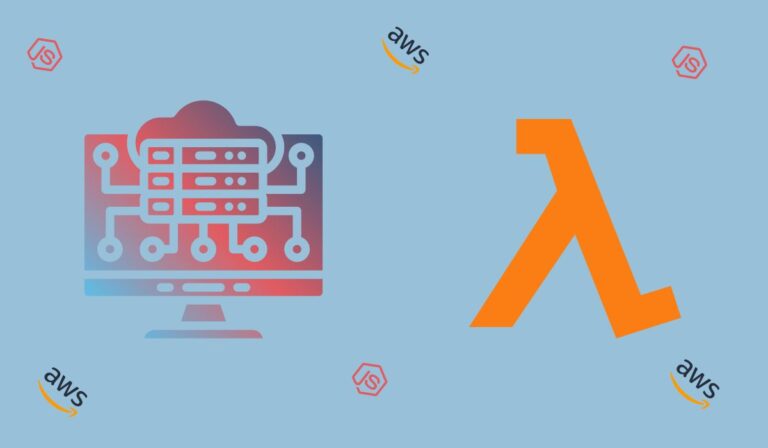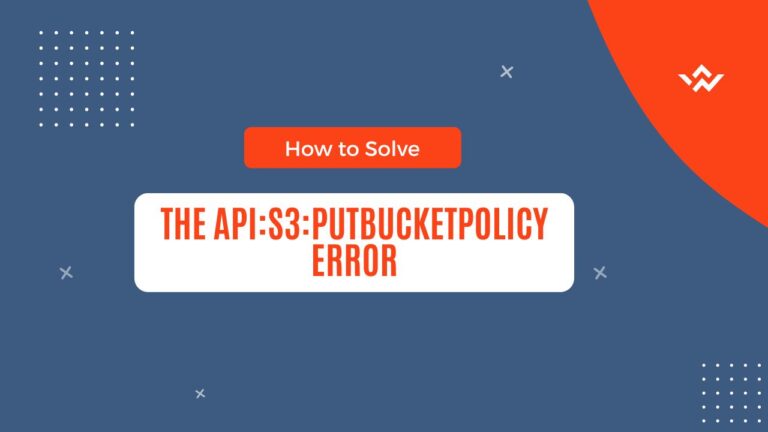In the world of serverless architecture, developers have access to a variety of tools and frameworks that simplify the process of building and deploying applications. Two popular options in this space are the Serverless Framework and the AWS Serverless Application Model (SAM). Both tools aim to streamline the development workflow and enable efficient deployment of serverless applications on cloud platforms.
This article aims to provide a comprehensive comparison between the Serverless Framework and SAM, highlighting their similarities, differences, use cases, and key features. Whether you’re a seasoned developer or new to serverless, understanding these tools will empower you to make informed decisions for your serverless projects.
What we’ll cover
-
Serverless Framework vs. SAM: A Head-to-Head Comparison
-
Conclusion : Chossing the Right Tool – Serverless Framework vs. AWS SAM
Serverless Framework vs SAM: Feature Comparison
To better understand the capabilities and suitability of these tools, let’s examine their features side by side. Here’s a detailed comparison table:
| Features | Serverless Framework | AWS SAM |
|---|---|---|
| Cloud Provider Support | Multi-cloud support | AWS specific |
| Abstraction Level | High level configuration | Infrastructure-as-code |
| Local Development | Supported | Supported (via SAM CLI) |
| Deployment | Simplified deployment | Leveraging AWS CloudFormation |
| Integration with AWS | Semaless integration | Tight Integration with AWS |
| Community and Ecosystem | Vibrant ecosystem | AWS Cloudformation community |
| Language Support | Multiple languages | Multiple languages |
| Flexibility | High | AWS-specific |
| Learning Curve | Moderate | Moderate to steep |
| Event-Driven Architecture | Built-in event support | Built-in event support |
| Plugin Ecosystem | Rich ecosystem | Cloudformation ecosystem |
| Vendor Lock-in | Reduced risk | AWS-specific |
This detailed feature comparison will serve as a valuable reference as we explore each tool’s strengths, use cases, and considerations. Let’s dive into the specifics of the Serverless Framework and AWS SAM to gain a deeper understanding of their capabilities and determine which one aligns better with your project requirements.
Serverless Framework vs SAM: A Head-to-Head Comparison
What is the Serverless Framework ?

The Serverless Framework is an open-source development tool that allows developers to build, deploy, and manage serverless applications effortlessly. It provides a unified experience across various cloud providers, including AWS, Azure, and Google Cloud. The framework offers a high-level configuration language and abstracts away the underlying cloud infrastructure complexities, enabling developers to focus on writing application code rather than dealing with infrastructure management.
Key Features of the Serverless Framework
- Multi-Cloud Support: The Serverless Framework is not limited to a single cloud provider.
- Easy Deployment: With a simple sls deploy command, developers can package their applications, provision necessary resources, and deploy them to the cloud.
- Event-Driven Architecture: The framework embraces the serverless paradigm of event-driven computing. It provides built-in support for event triggers and enables seamless integration with various event sources like API Gateway, SNS, and SQS.
- Rich Plugin Ecosystem: The Serverless Framework boasts a vast plugin ecosystem that extends its capabilities.
- Local Development and Testing: The framework supports local development and testing, allowing developers to iterate quickly and validate their application logic before deploying to the cloud.
Real-World Examples of Serverless Framework Implementations
The Serverless Framework has been successfully implemented by several prominent companies across various industries. Let’s explore some brief examples
- Coca-Cola: Coca-Cola utilized the Serverless Framework to build a serverless architecture for their Coca-Cola Freestyle app, enabling users to create custom beverage mixes and order drinks from their mobile devices.
- Netflix: Netflix leveraged the Serverless Framework to develop their content recommendation system, processing massive amounts of user data to deliver personalized recommendations to subscribers.
- Ticketmaster: Ticketmaster adopted the Serverless Framework to enhance their event registration and management processes, simplifying ticket purchases, event notifications, and customer data management.
- Airbnb: Airbnb implemented the Serverless Framework to enhance their search and recommendation functionalities, allowing users to find and book accommodations based on their preferences and past bookings.
- NASA Jet Propulsion Laboratory (JPL): JPL utilized the Serverless Framework for their Mars Rover Image API, enabling scientists and the public to access and analyze images captured by the Mars Rover.
These examples demonstrate the versatility of the Serverless Framework in enabling companies to develop scalable and efficient solutions across industries such as food and beverages, media streaming, ticketing, hospitality, and space exploration. By leveraging the power of serverless computing, these organizations have achieved cost savings, scalability, and enhanced user experiences.
To learn more about serverless development using the Serverless Framework and typescript, check out our comprehensive guide to build a serverless rest api with Typescript
What is AWS SAM?
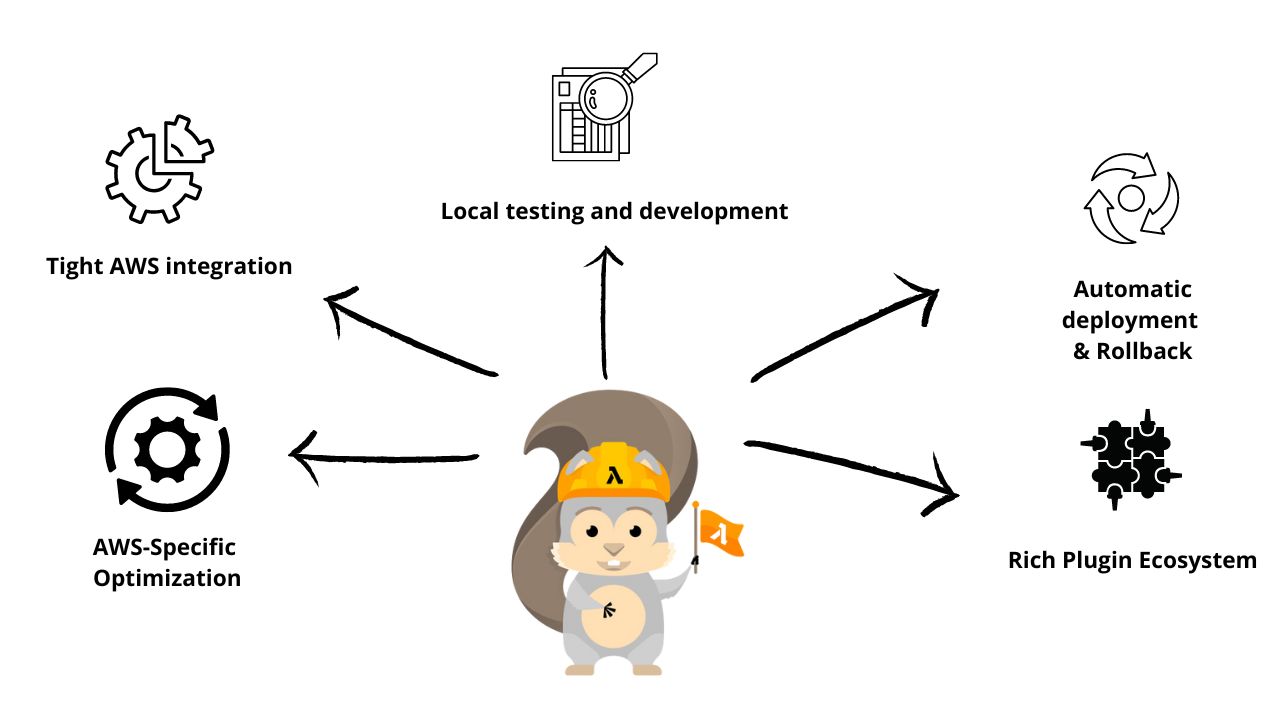
AWS SAM, short for AWS Serverless Application Model, is a framework provided by Amazon Web Services (AWS) for building serverless applications. It extends AWS CloudFormation, a popular infrastructure-as-code tool, with serverless-specific resources and deployment capabilities. SAM simplifies the process of defining and deploying serverless applications on AWS, leveraging the familiarity and power of CloudFormation.
Key Features of AWS SAM
- Tight Integration with AWS Services: SAM integrates seamlessly with various AWS services, such as AWS Lambda, API Gateway, DynamoDB, and S3.
- Local Development with SAM CLI: SAM CLI (Command Line Interface) enables local development and testing of serverless applications.
- Lambda Function Templates: SAM provides predefined templates for common application patterns, such as APIs, queues, and stream processing.
- Automatic Deployment and Rollback: SAM leverages AWS CloudFormation for application deployment. It enables automatic stack creation, update, and rollback in case of failures, ensuring reliable and consistent deployments.
- AWS-Specific Optimization: SAM applies optimizations specific to AWS services, improving the performance and efficiency of serverless applications. It automatically sets up appropriate IAM roles, configures security policies, and optimizes resource allocation.
Real-World Examples of AWS SAM Implementations
AWS SAM (Serverless Application Model) has been widely adopted by organizations across industries for building serverless applications on Amazon Web Services. Here are a few brief examples of how companies have successfully utilized AWS SAM:
- Nordstrom: Nordstrom automated their order processing using AWS SAM, resulting in improved efficiency and faster order delivery.
- Zillow: Zillow implemented AWS SAM to build a scalable data processing pipeline, enabling faster and more accurate real estate listings and analytics.
- Live Nation: Live Nation developed a high-demand ticketing system with AWS SAM, ensuring smooth ticket sales during popular events without manual scaling.
- Fintech Startup: A fintech startup leveraged AWS SAM to build secure and scalable microservices for processing financial transactions.
- Healthcare Provider: A healthcare provider utilized AWS SAM to develop a real-time notification system for appointment management, improving patient care and reducing no-shows.
These examples demonstrate how AWS SAM has enabled organizations to build efficient, scalable, and cost-effective serverless applications across industries such as retail, real estate, entertainment, finance, and healthcare. By leveraging the power of AWS Lambda and other AWS services, these companies have achieved significant operational improvements and enhanced customer experiences.
Choosing the Right Tool for Your Serverless Development
Choosing between the Serverless Framework and SAM depends on various factors, including your specific requirements, familiarity with the tools, target cloud platform, and integration needs. Let’s explore some key considerations when making this decision.
Flexibility and Multi-Cloud Support
The Serverless Framework offers unparalleled flexibility when it comes to cloud provider choice. If your application needs to run on multiple cloud platforms or you anticipate switching providers in the future, the Serverless Framework’s multi-cloud support becomes a significant advantage. It provides a consistent development experience across providers, reducing vendor lock-in risks and enabling seamless migration.
On the other hand, if you are primarily building serverless applications on AWS and have no immediate plans to switch providers, AWS SAM’s tight integration with AWS services can simplify your development workflow. SAM leverages the full power of CloudFormation, allowing you to define complex architectures and manage infrastructure-as-code alongside your serverless resources.
Development Workflow and Abstraction
The Serverless Framework focuses on abstracting away the cloud infrastructure details, allowing developers to write serverless applications with ease. Its configuration language provides a concise and human-readable way to define resources, events, and their relationships. This abstraction enables faster development cycles and a more developer-friendly experience.
In contrast, AWS SAM builds upon AWS CloudFormation, which is a more comprehensive infrastructure-as-code tool. While this brings additional power and control, it also introduces a steeper learning curve. Developers familiar with CloudFormation might find SAM’s syntax and workflow more natural, but those new to infrastructure-as-code might prefer the simplicity of the Serverless Framework.
Community and Ecosystem
Both the Serverless Framework and SAM boast vibrant communities and extensive ecosystems. The Serverless Framework’s plugin architecture allows developers to tap into a vast library of existing plugins or create their own to extend the framework’s capabilities. This rich ecosystem often provides ready-to-use solutions for common requirements, reducing development time and effort.
Similarly, AWS SAM leverages the AWS CloudFormation ecosystem, which includes a broad range of community-contributed templates and resources. Additionally, SAM CLI integrates with popular development tools like AWS Toolkit for Visual Studio Code, enhancing the developer experience for AWS-specific workflows.
FAQs
FAQ 1: Is the Serverless Framework only for JavaScript applications?
No, the Serverless Framework supports multiple programming languages, including JavaScript, Python, Java, and more. It provides language-specific templates and configurations to cater to various runtime environments.
FAQ 2: Can I use AWS SAM with cloud providers other than AWS?
No, AWS SAM is specific to AWS. It leverages AWS CloudFormation, which is tightly integrated with AWS services. If you plan to use multiple cloud providers, the Serverless Framework would be a better choice.
FAQ 3: Can I use the Serverless Framework with AWS services?
Absolutely! The Serverless Framework supports AWS and several other cloud providers. It provides dedicated plugins and configurations for seamless integration with various AWS services.
FAQ 4: Which tool has better support for local development and testing?
Both the Serverless Framework and AWS SAM offer robust support for local development and testing. The Serverless Framework’s offline mode and SAM CLI enable developers to run functions locally, emulate API Gateway endpoints, and test their applications effectively.
FAQ 5: Is it possible to mix the Serverless Framework and AWS SAM in a single project?
Yes, it is possible to mix the Serverless Framework and AWS SAM within the same project. However, this might introduce complexities due to differences in configuration and deployment mechanisms. It is advisable to choose a single tool for consistency and simplicity.
FAQ 6: Are there any performance differences between the Serverless Framework and AWS SAM?
In terms of performance, both tools leverage the underlying cloud provider’s capabilities and optimizations. The performance of your serverless applications will primarily depend on factors such as function design, resource allocation, and service configurations rather than the choice of framework or tool.
Conclusion : Choosing the Right Tool – Serverless Framework vs. AWS SAM
In the world of serverless development, choosing the right tool is crucial. Both the Serverless Framework and AWS SAM offer powerful solutions for building scalable serverless applications.
The Serverless Framework provides multi-cloud support, easy deployment, and a rich plugin ecosystem, making it a flexible choice. AWS SAM, on the other hand, excels in its tight integration with AWS services and streamlined development workflow on the AWS platform.
When deciding between the Serverless Framework and AWS SAM, consider factors such as multi-cloud support, preferred development workflow, and integration needs. The Serverless Framework is ideal for those seeking multi-cloud flexibility, while AWS SAM caters to those primarily focused on AWS.
By selecting the tool that aligns with your requirements and platform preferences, you can unlock the full potential of serverless architecture and deliver scalable, cost-effective applications.

